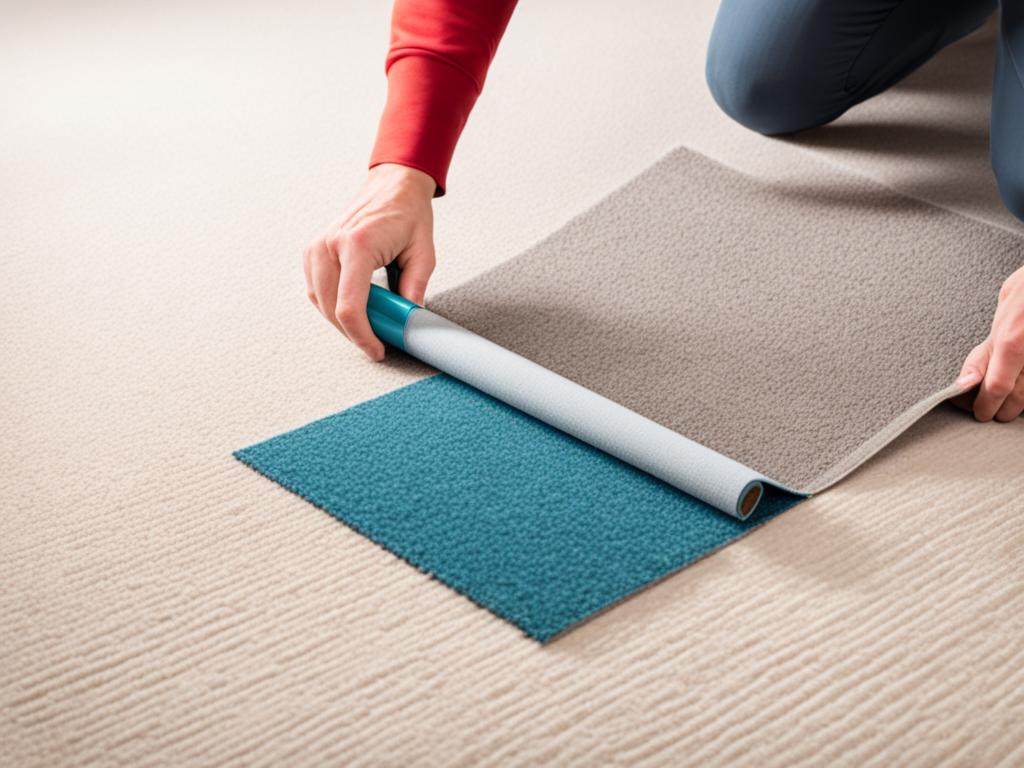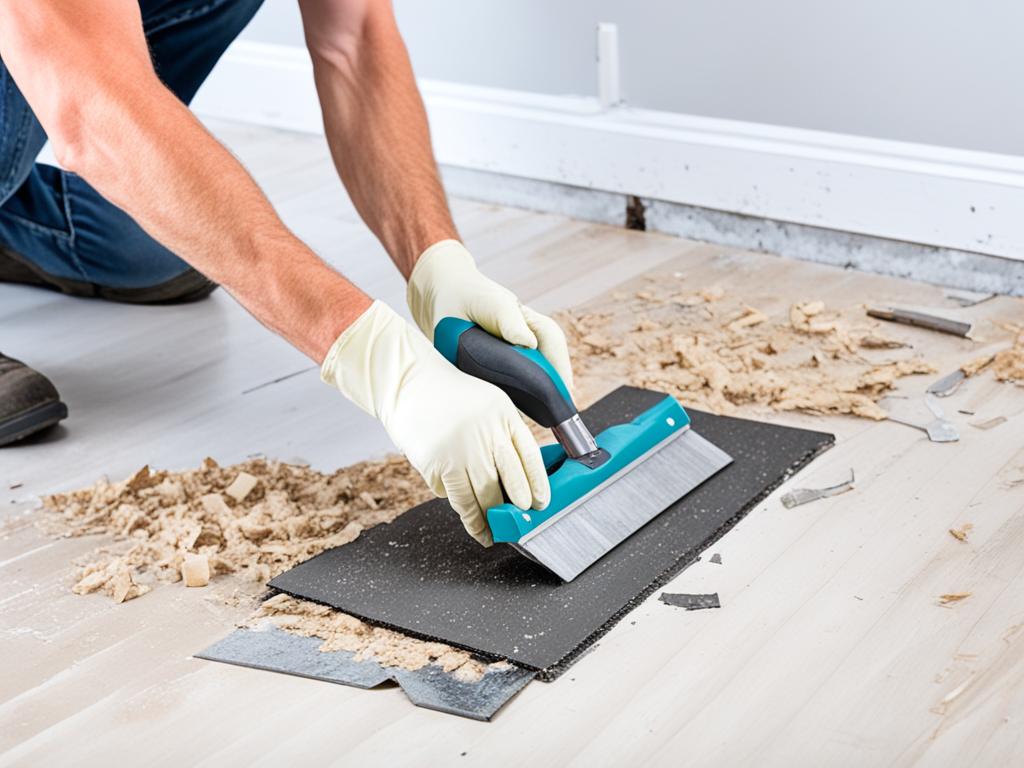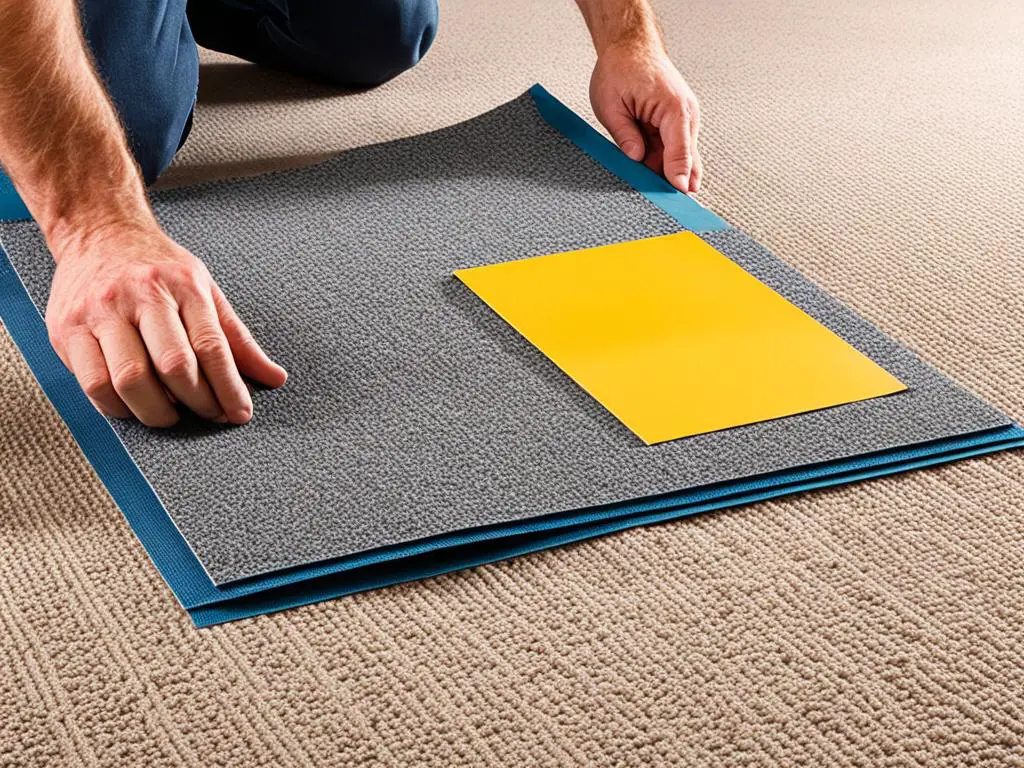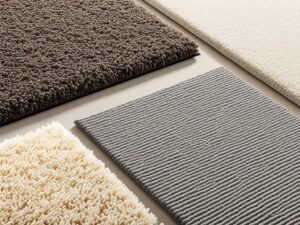Are you looking for a cost-effective solution to upgrade your flooring? Installing carpet tiles over existing carpet can be a great option. Whether you want to freshen up the look of your space or create a more durable surface, carpet tiles offer convenience and customization.
When it comes to installing carpet tiles over carpet, there are a couple of options to consider. One option is to clean the existing carpet thoroughly to ensure it is free from dirt and debris. If you are installing over a thin pile carpet, you can typically lay the carpet tiles directly on top. However, if you are installing over a thick pile carpet, it is advisable to line the floor with plywood boards to prevent uneven areas. By following these steps, you can easily install carpet tiles over carpet for a smooth and durable flooring upgrade.
Key Takeaways:
- Clean the existing carpet before installing carpet tiles.
- If the existing carpet is thin, lay the carpet tiles directly on top. If it’s thick, use plywood boards to create a level surface.
- Carpet tiles offer a cost-effective and customizable flooring solution.
- Carpet tiles are suitable for high-traffic areas and can be easily replaced if damaged.
- Consider the quality and durability of the carpet tiles for long-lasting results.
Tips for Carpet Tile Installation
When it comes to installing carpet tiles over existing carpet, there are a few important tips to consider. Following these tips will ensure a successful and long-lasting installation. Here are some best practices for DIY carpet tile installation:
- Thoroughly clean and dry the existing carpet: Before laying the new carpet tiles, it is crucial to clean the existing carpet to remove any dirt, debris, or stains. This will provide a clean and smooth surface for the installation.
- Choose the right type of carpet tile: Consider whether the carpet tiles have an adhesive backing or if they require carpet tile glue. This will determine the installation method you need to follow.
- Ensure a level and clean subfloor: Before fitting the carpet tiles, make sure the subfloor is level and free of any debris. Any unevenness can affect the overall appearance and durability of the installation.
- Invest in durable and high-quality carpet tiles: To ensure the longevity of your carpet tile installation, opt for durable and high-quality tiles. This is especially important for high-traffic areas where the tiles will undergo more wear and tear.
By keeping these tips in mind, you can achieve a successful DIY carpet tile installation over existing carpet. Following the best practices for carpet tile installation will result in a beautiful and durable flooring upgrade for your space.
Quote:
“By keeping these tips in mind, you can achieve a successful DIY carpet tile installation over existing carpet.”

| Tips | Description |
|---|---|
| Thoroughly clean and dry the existing carpet | Before laying the carpet tiles, ensure that the existing carpet is clean and dry to create a suitable surface for the installation. |
| Choose the right type of carpet tile | Determine whether the carpet tiles have an adhesive backing or if they require carpet tile glue to select the appropriate installation method. |
| Ensure a level and clean subfloor | Prior to fitting the carpet tiles, make sure the subfloor is level and free of any debris to achieve a smooth and professional-looking installation. |
| Invest in durable and high-quality carpet tiles | To ensure the longevity of the installation, choose durable and high-quality carpet tiles, especially for high-traffic areas. |
Benefits of Carpet Tiles Over Carpet
Installing carpet tiles over existing carpet offers several advantages that make them a popular choice for flooring upgrades. Here are some of the key benefits:
- Cost-effective: Carpet tiles are a more affordable option compared to traditional carpet. They provide a budget-friendly solution for those looking to enhance their space without breaking the bank.
- Durable: Carpet tiles are designed to withstand heavy traffic and regular wear and tear. They are a durable flooring option that can withstand the demands of both residential and commercial environments.
- Easy Replacement: Unlike traditional carpet, individual carpet tiles can be easily replaced if they become worn or damaged. This eliminates the need to replace the entire carpet, making maintenance and repairs more convenient and cost-effective.
- Design Flexibility: Carpet tiles come in a wide variety of colors, patterns, and textures, allowing for endless design possibilities. They can be mixed and matched to create unique and personalized flooring designs that suit any style or aesthetic.
Get Creative with Carpet Tiles
“Carpet tiles offer endless design possibilities. Mix and match colors and patterns to create a unique flooring design that reflects your personal style and enhances the overall aesthetics of your space.”

With the numerous benefits they offer, it’s no wonder why carpet tiles have become a popular choice for people looking to upgrade their flooring. From their cost-effectiveness and durability to their versatility and easy maintenance, carpet tiles provide a practical and stylish solution for any room or space.
Preparing the Subfloor for Carpet Tile Installation
Before installing carpet tiles over carpet, it is important to properly prepare the subfloor to ensure a successful and long-lasting installation. Taking the time to prepare the subfloor will help create a solid foundation for the carpet tiles, ensuring they adhere properly and provide a smooth and even surface.
The following steps outline the process of preparing the subfloor for carpet tile installation:
- Clean the subfloor: Start by thoroughly cleaning the subfloor to remove any dirt, dust, or debris. This will ensure that the carpet tiles adhere properly and create a clean and professional look.
- Check for solid and dry surface: Inspect the subfloor to ensure it is solid and free from any structural issues. Additionally, make sure the subfloor is dry before proceeding with the installation to prevent any moisture-related issues.
- Level the subfloor: If the subfloor has any uneven areas or low spots, it is important to level them before installing the carpet tiles. Use a leveling compound to fill in any depressions and create a smooth and level surface.
- Repair cracks and damage: Inspect the subfloor for any cracks, damaged areas, or loose boards. Repair or replace any damaged sections to create a stable and secure subfloor.
- Apply a floor primer (if necessary): Depending on the type of subfloor and adhesive used, applying a floor primer may be necessary. The primer will help improve the adhesion of the carpet tiles and prevent moisture-related issues.
- Allow the subfloor to rest: Once the subfloor has been cleaned, leveled, and repaired, allow it to rest for at least 24 hours. This will ensure that any leveling compound or primer has properly cured before proceeding with the installation.
By following these steps, you can effectively prepare the subfloor for carpet tile installation, ensuring a smooth, durable, and professional-looking flooring solution.

Calculating and Gathering Materials for Carpet Tile Installation
Before you begin installing carpet tiles over carpet, it’s important to calculate the materials needed for a smooth and successful installation. By accurately determining the number of tiles required and gathering the necessary tools, you can save time and ensure a seamless process.
Calculating the Number of Carpet Tiles
To determine the number of carpet tiles you’ll need, start by measuring the length and width of the room in inches. Multiply these two measurements to find the total area of the room.
Next, divide the area of the room by the surface area of a single carpet tile. This will give you the approximate number of tiles required. It’s recommended to purchase an additional 10% of carpet tiles to account for mistakes during installation and for future repairs.
Gathering Tools for Carpet Tile Installation
In addition to the carpet tiles, gather the following tools to ensure a smooth installation process:
- Carpet cutter or utility knife: Used for cutting tiles to fit around edges and corners.
- Adhesive (if applicable): Some carpet tiles may require adhesive for proper installation. Check the manufacturer’s instructions.
- Fan: Helps to accelerate the drying process, especially if adhesive is used.
- Vacuum or broom: Ensures the existing carpet is clean and free from debris.
- Level: Used to check the flatness of the subfloor and ensure a level installation.
- Measuring tape: Essential for accurate measurements of the room dimensions.
- Chalk line: Helps to create straight layout lines for the carpet tile installation.
- Floor primer (optional): Prepares the subfloor for proper adhesion of the carpet tiles.
With these tools and materials in hand, you’ll be well-prepared to install carpet tiles over carpet for a beautiful and durable flooring solution.
Step-by-Step Guide to Installing Carpet Tiles Over Carpet
Installing carpet tiles over carpet can be a straightforward process when following these step-by-step instructions:
- Clean the existing carpet thoroughly and ensure it is completely dry before proceeding with the installation.
- If you are installing carpet tiles over a thin pile carpet, you can lay the tiles directly on top without any additional preparations. However, if you are installing over a thick pile carpet, it is recommended to line the floor with plywood boards to create a level surface.
- Start the installation process by finding the center of the room and mark it using chalk lines. This will serve as a guide for laying out the carpet tiles.
- Install the carpet tiles according to the manufacturer’s instructions. You can use either the peel and stick method or apply adhesive if necessary.
- Trim the perimeter tiles to fit between the wall and the last full-size tile using a carpet cutter or utility knife.
- Once all the tiles are in place, use a floor roller to ensure proper adhesion and eliminate any air bubbles or unevenness.
- Reinstall any baseboard or molding that was temporarily removed during the installation process.
- Finally, vacuum the entire floor to remove any debris or loose fibers.
Following these steps will enable you to successfully install carpet tiles over carpet, creating a beautiful and durable flooring solution.
Tips for Carpet Tile Installation Success
To ensure a successful carpet tile installation over carpet, consider the following tips:
- Make sure the existing carpet is thoroughly cleaned and dry before installing the carpet tiles.
- Follow the manufacturer’s instructions for adhesive application if using adhesive-backed tiles.
- Use a notched trowel to spread adhesive evenly for a secure bond.
- Mix carpet tiles from different packs to account for variations in dye lots.
- Cut perimeter tiles carefully to fit snugly against walls or other obstacles.
- Roll the floor thoroughly after installation to ensure proper adhesion of the tiles.
- Consider hiring a professional carpet fitter for complex installations or if unsure about DIY installation.
Following these tips will help you achieve a successful carpet tile installation over your existing carpet, creating a beautiful and functional flooring solution.
Conclusion
Installing carpet tiles over existing carpet offers a practical and cost-effective solution for upgrading your flooring. By following the proper steps, such as thorough subfloor preparation and careful tile calculation, you can achieve a professional and durable result. The benefits of carpet tiles are numerous, including easy replacement of individual tiles, design flexibility, and suitability for high-traffic areas.
Whether you choose to tackle the installation yourself or hire a professional, the process of installing carpet tiles over carpet can be a rewarding project that enhances both the look and functionality of your space. With their affordability and wide range of colors and patterns, carpet tiles provide endless possibilities for customization, allowing you to create a flooring design that reflects your style and personality.
So why wait? Transform your space with carpet tiles and enjoy the benefits they bring. Upgrade your flooring with confidence, knowing that the installation process is straightforward and the outcome will be a beautiful and resilient carpeted surface.




